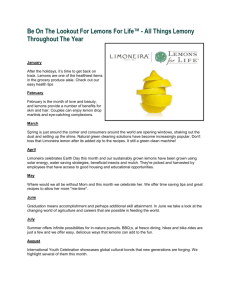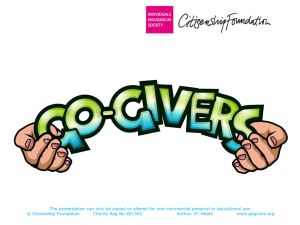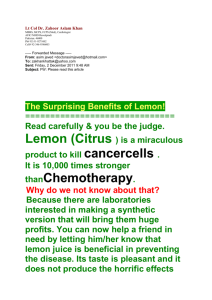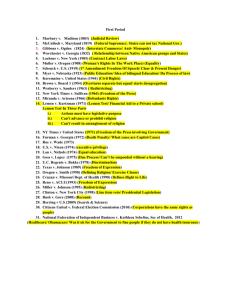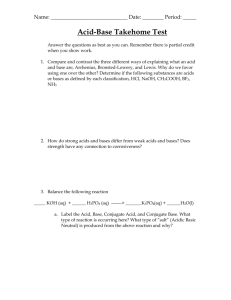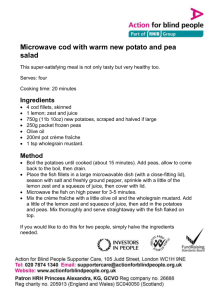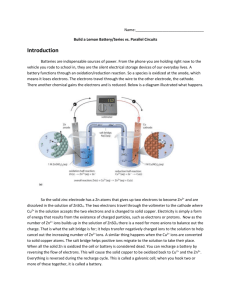File
advertisement
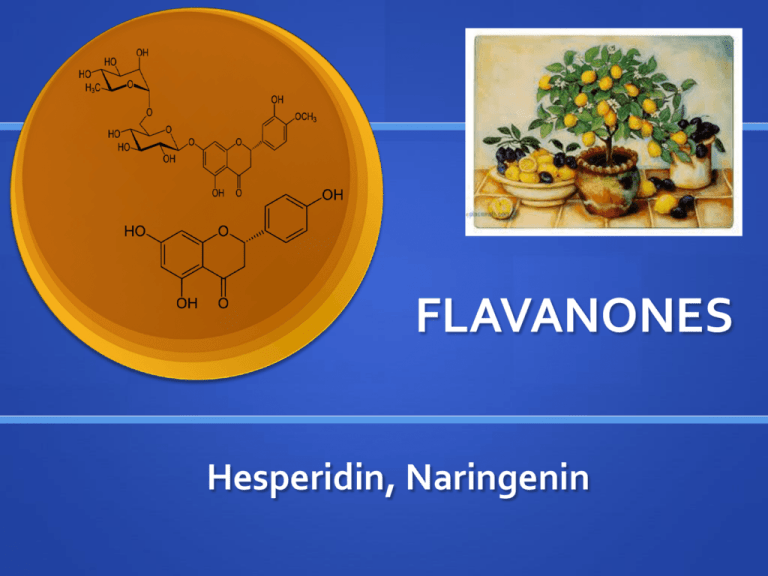
FLAVANONES Hesperidin, Naringenin Flavanones The most abundant citrus flavanoid; 98% in grapefruit, 96% in limes and 90% in lemons A type of flavanoid with several chemical variations. These include Hesperidin, Naringenin, Eriodictyol, Sterubin, Butin, and many others Primary focus today is HESPERIDIN Highest content is in lemons Genus of flowering CITRUS plants in the Rue family, Rutaceae Lemons are further classified as citrus limon Fruit is hesperidium “Lemons, …. commonly known as the fruit that evokes images of sunshine and the sweet smiles of children standing roadside at their homemade lemonade stands” G. Mateljan, www.whfoods.com The History of Lemons Lemons originally developed as a cross of lime & citron and thought to have originated in China and India 2500 years ago Brought to the Americas by Christopher Columbus in 1493 Prized by California Gold Rush miners to prevent scurvy;1849 United States, Italy, Spain, Greece, Israel, &Turkey are the main producers in the marketplace today Availability in the marketplace California/Arizona Citrus produce 95% of the lemons in the US Availability in the marketplace Florida Citrus Availability in the marketplace Texas Citrus Imported Citrus Listing of lemon cultivars of commercial importance worldwide Lemon Cultivars Other Names Bears Berna Location(s) Florida Verna, Bernia, Vernia Eureka Spain, Algeria, Morocco S. Africa, Argentina, Australia, California, Greece, Israel, Mexico, Pakistan, China, Arizona, Florida Femminello ovale or Feminello comune Commune, Ruvittaru Sicily Interdonato Speciale Sicily Kusner Russia Lisbon California, Algeria, China, Greece, Mexico, Morocco, Argentina, Portugal Mesero Fino, Primifiori Italy, Spain Monachello Moscatello Italy Monroe California Sicilian lemon Brazil Villafranca Sicily, California Health Benefits Contain important natural chemical components: Phenolic compounds - mainly flavonoids Vitamins - especially vitamin C Minerals – especially potassium Fiber Carotenoids Essential oils Health promoting properties associated with vitamin C and flavanoid content due to natural antioxidant characteristics Important part of a balanced diet for role in prevention of disease Health Benefits Experimental data from in vitro, in vivo and clinical trials in support of the health-promoting activity of lemon and its bioactive compounds: Cancer - esophagus, mouth, stomach and colon Cardiovascular, coronary heart disease and oxidative damage Lipid metabolism and obesity Gastrointestinal diseases Diabetes Antimicrobial activity Urinary diseases Psychiatric diseases Bone protection Health Benefits Citrus fruits may be among the fruits with the greatest cancer fighting potential. This is especially true in the cancers of the esophagus, mouth, stomach and colon Anti cancer benefits are mainly due to significant quantities of monoterpenes and flavanones which are believed to cut the risks of cancers of the digestive track in half. These compounds reduce cancer risks in two significant ways: 1. Interfere with some of the processes necessary for cancer cell growth, making it difficult for tumors to develop. 2. Inhibit inflammation, a stimulus for cancer cell growth. Health Benefits Citrus flavonoids act as modulators of tyrosine kinases – important implications in treatment of cancer Eriocitrin (from lemon juices and its metabolites) was tested in different Citrus juices by Ogata et al. and showed that it induced apoptosis in HL-60 cells Hesperidin in different citrus juices showed antiproliferative activity Lemons showed relatively potent antiproliferative activities on HepG2 human liver cancer cell growth Other studies showed eriocitrin as an inhibitory compound acting against both rat platelet 5- and 12-lipoxygenases, and its aglycone, eriodictyol, was a much more potent inhibitor of these lipoxygenases involved in biosynthesis of various bioregulators closely related to the pathogenesis of several diseases such as allergies, atherosclerosis and cancer Health Benefits Digestion Lemon added to warm water helps the digestive tract. Natural acidity helps to stimulate the liver increasing bile secretions. This causes the digestive tract to move more efficiently, resulting in better digestion. Lemon water can also help to eliminate constipation and nausea and may also treat worm infestations of the digestive tract. Flush Toxins Lemon also has antibacterial properties. Good for throat infections and tonsillitis because of its antibacterial content and diuretic properties. When consumed with water, has the ability to flush toxins and bacteria out of the system, making it an especially effective treatment for ailments of the blood and organic systems of the body. Health Risks Gastroesophageal Reflux Acidic citrus fruits may increase esophageal irritation and exacerbate GERD symptoms. Acidity can also lead to gastric ulcer irritation. Dental Erosion The acids in lemon juice eat away at the enamel, the shiny surface component of teeth that protects from decay. Erosion can lead to surface staining, cavities and sensitivity if prolonged exposure continues. Medicine Interactions The FDA has clearly defined a link between altered drug metabolism and citrus fruit juices. As little as 120mL of lemon juice contains 5.9g of citric acid, which is shown to decrease the blood levels of chloroquine, which is used by those entering an area with a high risk of malarial infection. Health Risks Lemon and Lime Peels and Oxalates The peels of lemons are among a small number of foods that contain measurable amounts of oxalates. When oxalates become too concentrated in body fluids, they can crystallize and cause health problems. So, individuals with already existing and untreated kidney or gallbladder problems may want to avoid eating lemon or lime peels. Lemons and Limes and Wax Coatings Conventionally grown lemons may be waxed to protect from bruising during shipping. Plant, insect, animal or petroleum-based waxes may be used. Carnauba palm is the most common plant-source wax. Other compounds, such as ethyl alcohol or ethanol, are added to the waxes for consistency, milk casein for "film formers" and soaps for flowing agents. Since you may not be able to determine the source of waxes, another good reason to choose organically grown lemons. Flavonone content in lemons and pure lemon juice http://www.phenol-explorer.eu/ Varieties of Lemons Eureka – o texturized skin, a short neck at one end and a few seeds o Sour flavor o Originated in California o Forms an open, spreading tree, with relatively few branches and twigs which are virtually thornless o Production occurs mostly in spring and summer Varieties of Lemons Lisbon – o smoother skin, no neck and is generally seedless o Sour flavor o Originated in Australia o Characterized by a rather dense tree having numerous upright, thorny branches o Production occurs mostly in summer and fall Varieties of Lemons Meyer o They are more round a have a smooth unpitted skin o As they mature they become deep yellow to orange takes on a deep yellow to orange color when mature. o tangy aroma and less acidic. o introduced from China in 1908 o The tree is spreading and relatively small, nearly thornless and more cold tolerant than true lemons o Production occurs mostly in winter Major Lemon Growers Worldwide González-Molina E., Domínguez-Perles R., Moreno D.A., García-Viguera C. Natural bioactive compounds of Citrus limon for food and health. Journal of Pharmaceutical and Biomedical Analysis.2010:51:327–345. Terry, Leon A. Health-promoting Properties of Fruits and Vegetables. Wallingford, Oxfordshire: CABI, 2011.96-105. Bioavailability of flavonoids in Lemons Citrus flavonoids can exist as free aglycones but most of them commonly occur as C- or O-glycosides In lemons the sugars, rutinosides are tasteless Distribution throughout the fruit: Juice: hesperidin and eriocitrin Peel: hesperidin, eriocitrin, neoeriocitrin, neohesperidin and naringin and minor amt of narirutin Seeds: hesperidin and eriocitrin, low amts of naringin Guihua X., Donghong L., Jianchu C., XingqianY., Yaqin M., John S. Juice components and antioxidant capacity of citrus varieties cultivated in China. Food Chemistry.2008:106:545–551. Growing Conditions CLIMATE: o Not cold tolerant o Mediterranean climate Soil Type: o Well adapted to virtually any soil type o Require full sunlight for optimum growth and production o Good drainage Growing Conditions and Bioactivity The concentration of bioactives is influenced by the following factors: o Cultivar (rootstock & scion) o Climate o Cultural practices during production o Position of the fruit tree o Fruit maturation o Post harvest treatments Handling, storage and transportation of fruit Absorption of flavonoids O-glucosides undergo intestinal hydrolysis to release aglycones Hesperidin and hesperetin may be metabolized into hesperetin after oral administration Eriocitrin is metabolized to eriodictyol (aglycone) in intestional flora Post ingestion hesperetin and erodictyol were detected in human urine and plasma as the glucuro-and/or sulfoconjugates - suggesting these undergo extensive phase II metabolism Most absorbed Citrus flavanones undergo glucuronidation before urinary excretion Storing Lemons: nutrient content Fruit: maintains its levels of juice, vitamins, minerals, fibers and carbohydrates for several months Fruit and juice: suffer degradation of vitamin C during storage or industrial process (pasteurization) Oxygen, heat light, storage temperature, and storage time affect ascorbic acid retention in juices. To prevent loss of ascorbic acid: o Keep at 0-5o C and protected from water loss Pasteurization does not modify hesperidin content Storage and Processing •Stay fresh at room temperature, away from exposure to sunlight, for about one week. •Can be stored in the refrigerator crisper and will keep for about four weeks. •Fresh juice storage; squeeze into ice trays and freeze stored in plastic freezer bags •Zest storage; dry and store in a cool dry place in an airtight glass container. Choosing the best Lemon • Look for thin skinned lemons since they have more flesh and juice; choose lemons that are heavy for their size, with peels that have a grainy surface • Bright yellow fruit indicates that the lemon is at the peak of ripeness. Cooking with Citrus Peel •Xu et al. reported in 2008 on the efficiency of heat infusion to extract both minerals and phenolic compounds, including flavanone glycosides from citrus varieties. •Peels of 2 varieties ( Satsuma & Ponkan mandarin) were selected & boiled in hot water to extract minerals & phenolics. •The result showed that this was an efficient means of extracting many phenolics and minerals, however, hesperidin was the most difficult to extract, suggesting that it is more tightly bound within its food matrix there. •The study also showed that the antioxidant capacity of the citrus peels boiled in hot water was almost the same as that extracted with methanol. •Lengthening time or raising temperature extracted more in 2 studies Cooking with Lemons •The bioactives in citrus partly determine the unique flavor. Neohesperidosides in grapefruits are intensively bitter, but rutinosides, in lemons, are tasteless. •Peels are the main fiber content in lemons & pectin is the major component of fiber in the lemon. •Recently, research has been focused on the lemon in comparison to major carotenoid components of orange species varieties, showing that lemon contains reasonable quantities of carotenoids for a daily nutritional source of these bioactives. •Lemons sprayed with pesticides may be toxic for humans or animals, but also prompt changes in essential oil composition as an effect on plant metabolism. Cooking with Lemons • The juice can be used to prevent browning • The acidic lemon juice can be exchanged for vinegar in dressings •Limoncello liquor is made by macerating lemon peels free of pesticide residues in ethanol, water &sugar. • Preserved lemons are a popular condiment in Indian, North African, and Moroccan cuisines •Candied Lemon Peel can make great holiday gifts and can be dipped in dark chocolate for an added bioactive bonus! •Lemon juice in water stimulates bile flow in the mornings or before meals. • The acidity of lemon juice brings everything into balance as you finish preparing a dish. Cooking with Lemons; Juicing • To get the most juice out, press down on it while rolling it back and forth on the counter, then juice it. • A good juicy lemon, contains ¼ cup of fresh lemon juice. Natural beauty tips! • Natural facial-boil orange and grapefruit peels with 2 cups of non-carbonated mineral water. Strain liquid into a bottle and apply to face twice daily. Keep refrigerated • Skin bracer-blend juice of half a grapefruit with warm water and splash on face immediately after washing to tighten pores. • To soften rough red elbows, dip and rub into grapefruit halves for two or three days. • To soften cuticles and whiten nails, mix 3 cups warm water with the juice of half a grapefruit. Soak fingers for 5 minutes. Recipe Ingredients Zest from 1 organic lemon, finely diced 1 cup water 1/2 cup turbinado 1/2 cup fresh lemon juice 1/2 cup carbonated mineral water 6 strips of lemon zest, for garnish Directions In a saucepan, stir together the lemon zest, 1 cup of water and turbinado. Bring to a boil, reduce heat to medium and simmer for 5 minutes. Remove from heat, and allow to cool. In a bowl, stir together the lemon syrup, lemon juice and mineral water. Pour into an ice cream maker, and freeze according to the manufacturer's instructions. Garnish each serving with a twist of lemon peel. If you do not have an ice cream maker, you may freeze it in a tall canister. Freeze for 1 1/2 hours. Remove and stir with a whisk. Return to the freezer and stir about once every hour for about 4 hours. The more times you stir, the more air will be incorporated, resulting in a lighter finished product. Discussion Topic References http://www.whfoods.com/genpage.php?tname=foodspice&dbid=27 http://www.phenol-explorer.eu/ http://www.sunkist.com/kids/facts/lemons.asp The End
